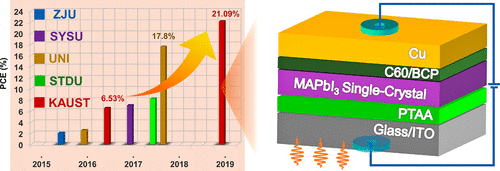当前位置:
X-MOL 学术
›
ACS Mater. Lett.
›
论文详情
Our official English website, www.x-mol.net, welcomes your
feedback! (Note: you will need to create a separate account there.)
Single Crystals: The Next Big Wave of Perovskite Optoelectronics
ACS Materials Letters ( IF 9.6 ) Pub Date : 2020-01-22 , DOI: 10.1021/acsmaterialslett.9b00290 Banavoth Murali 1 , Hema Kumari Kolli 1 , Jun Yin 2 , Ravi Ketavath 1 , Osman M. Bakr 2 , Omar F. Mohammed 2
ACS Materials Letters ( IF 9.6 ) Pub Date : 2020-01-22 , DOI: 10.1021/acsmaterialslett.9b00290 Banavoth Murali 1 , Hema Kumari Kolli 1 , Jun Yin 2 , Ravi Ketavath 1 , Osman M. Bakr 2 , Omar F. Mohammed 2
Affiliation

|
Contemporary advancements in perovskite semiconductors are visibly impacting the progress of light conversion applications. These alluring photo absorbers have gained wide consideration, because of their simple processing and striking optoelectronic properties. Although polycrystalline perovskite thin films exhibit phenomenal performance in energy-harvesting devices, they suffer from severe instabilities arising from morphological disorder and surface degradation under ambient conditions. Recent progress in perovskite single-crystals, which, in theory should outperform their polycrystalline thin-film counterparts, has been demonstrated to surmount these challenges, because of the exceptional optoelectronic properties, such as low trap density, high mobility, low intrinsic carrier concentration and long carrier diffusion length. However, most of the growth approaches used for single-crystal syntheses produce very thick crystals and subsequently, the related optoelectronic applications are very limited. Given the potential of perovskite single crystals, to break a new path for perovskite optoelectronic devices relies on understanding sustainable issues arising from interfacial/integration losses and developing passivation strategies to achieve performance parity in an open ambient atmosphere. Therefore, the current review provides a comprehensive overview of the advantages, limitations, and challenges associated with growth methods of single-crystals and their chemical stability, device configurations, photophysics, charge carrier dynamics, and photovoltaic applications.
中文翻译:

单晶:钙钛矿光电的下一波浪潮
钙钛矿半导体的当代进步明显地影响了光转换应用的进展。这些诱人的光吸收剂因其简单的加工和惊人的光电性能而得到了广泛的考虑。尽管多晶钙钛矿薄膜在能量收集装置中表现出惊人的性能,但它们却遭受了由形态异常和环境条件下的表面降解引起的严重不稳定性。由于钙钛矿单晶具有优异的光电性能,例如低陷阱密度,高迁移率,低本征载流子浓度和低载流子密度,因此在理论上应胜过多晶薄膜同行,因此,钙钛矿单晶的最新进展已被证明克服了这些挑战。长的载流子扩散长度。然而,用于单晶合成的大多数生长方法会产生非常厚的晶体,因此,相关的光电应用非常有限。鉴于钙钛矿单晶的潜力,要为钙钛矿光电器件开辟一条新道路,需要了解界面/集成损耗引起的可持续性问题,并制定钝化策略以在开放的环境中实现性能均等。因此,本综述全面概述了与单晶生长方法及其化学稳定性,器件配置,光物理,电荷载流子动力学和光伏应用相关的优势,局限和挑战。相关的光电应用非常有限。考虑到钙钛矿单晶的潜力,要为钙钛矿光电器件开辟一条新道路,就必须了解界面/集成损耗引起的可持续性问题,并制定钝化策略以在开放的环境中实现性能均等。因此,本综述全面概述了与单晶生长方法及其化学稳定性,器件配置,光物理,电荷载流子动力学和光伏应用相关的优势,局限和挑战。相关的光电应用非常有限。考虑到钙钛矿单晶的潜力,要为钙钛矿光电器件开辟一条新道路,就必须了解界面/集成损耗引起的可持续性问题,并制定钝化策略以在开放的环境中实现性能均等。因此,本综述全面概述了与单晶生长方法及其化学稳定性,器件配置,光物理,电荷载流子动力学和光伏应用相关的优势,局限和挑战。为钙钛矿光电器件开辟一条新路途,需要了解界面/集成损耗引起的可持续性问题,并制定钝化策略以在开放的环境中实现性能均等。因此,本综述全面概述了与单晶生长方法及其化学稳定性,器件配置,光物理,电荷载流子动力学和光伏应用相关的优势,局限和挑战。为钙钛矿光电器件开辟一条新路途,需要了解界面/集成损耗引起的可持续性问题,并制定钝化策略以在开放的环境中实现性能均等。因此,本综述全面概述了与单晶生长方法及其化学稳定性,器件配置,光物理,电荷载流子动力学和光伏应用相关的优势,局限和挑战。
更新日期:2020-01-23
中文翻译:

单晶:钙钛矿光电的下一波浪潮
钙钛矿半导体的当代进步明显地影响了光转换应用的进展。这些诱人的光吸收剂因其简单的加工和惊人的光电性能而得到了广泛的考虑。尽管多晶钙钛矿薄膜在能量收集装置中表现出惊人的性能,但它们却遭受了由形态异常和环境条件下的表面降解引起的严重不稳定性。由于钙钛矿单晶具有优异的光电性能,例如低陷阱密度,高迁移率,低本征载流子浓度和低载流子密度,因此在理论上应胜过多晶薄膜同行,因此,钙钛矿单晶的最新进展已被证明克服了这些挑战。长的载流子扩散长度。然而,用于单晶合成的大多数生长方法会产生非常厚的晶体,因此,相关的光电应用非常有限。鉴于钙钛矿单晶的潜力,要为钙钛矿光电器件开辟一条新道路,需要了解界面/集成损耗引起的可持续性问题,并制定钝化策略以在开放的环境中实现性能均等。因此,本综述全面概述了与单晶生长方法及其化学稳定性,器件配置,光物理,电荷载流子动力学和光伏应用相关的优势,局限和挑战。相关的光电应用非常有限。考虑到钙钛矿单晶的潜力,要为钙钛矿光电器件开辟一条新道路,就必须了解界面/集成损耗引起的可持续性问题,并制定钝化策略以在开放的环境中实现性能均等。因此,本综述全面概述了与单晶生长方法及其化学稳定性,器件配置,光物理,电荷载流子动力学和光伏应用相关的优势,局限和挑战。相关的光电应用非常有限。考虑到钙钛矿单晶的潜力,要为钙钛矿光电器件开辟一条新道路,就必须了解界面/集成损耗引起的可持续性问题,并制定钝化策略以在开放的环境中实现性能均等。因此,本综述全面概述了与单晶生长方法及其化学稳定性,器件配置,光物理,电荷载流子动力学和光伏应用相关的优势,局限和挑战。为钙钛矿光电器件开辟一条新路途,需要了解界面/集成损耗引起的可持续性问题,并制定钝化策略以在开放的环境中实现性能均等。因此,本综述全面概述了与单晶生长方法及其化学稳定性,器件配置,光物理,电荷载流子动力学和光伏应用相关的优势,局限和挑战。为钙钛矿光电器件开辟一条新路途,需要了解界面/集成损耗引起的可持续性问题,并制定钝化策略以在开放的环境中实现性能均等。因此,本综述全面概述了与单晶生长方法及其化学稳定性,器件配置,光物理,电荷载流子动力学和光伏应用相关的优势,局限和挑战。











































 京公网安备 11010802027423号
京公网安备 11010802027423号